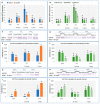HSP Transcript and Protein Accumulation in Brassinosteroid Barley Mutants Acclimated to Low and High Temperatures
- PMID: 32164259
- PMCID: PMC7084868
- DOI: 10.3390/ijms21051889
HSP Transcript and Protein Accumulation in Brassinosteroid Barley Mutants Acclimated to Low and High Temperatures
Abstract
In temperature stress, the main role of heat-shock proteins (HSP) is to act as molecular chaperones for other cellular proteins. However, knowledge about the hormonal regulation of the production of the HSP is quite limited. Specifically, little is known about the role of the plant steroid hormones-brassinosteroids (BR)-in regulating the HSP expression. The aim of our study was to answer the question of how a BR deficit or disturbances in its signaling affect the accumulation of the HSP90, HSP70, HSP18, and HSP17 transcripts and protein in barley growing at 20 °C (control) and during the acclimation of plants at 5 °C and 27 °C. In barley, the temperature of plant growth modified the expression of HSPs. Furthermore, the BR-deficient mutants (mutations in the HvDWARF or HvCPD genes) and BR-signaling mutants (mutation in the HvBRI1 gene) were characterized by altered levels of the transcripts and proteins of the HSP group compared to the wild type. The BR-signaling mutant was characterized by a decreased level of the HSP transcripts and heat-shock proteins. In the BR-deficient mutants, there were temperature-dependent cases when the decreased accumulation of the HSP70 and HSP90 transcripts was connected to an increased accumulation of these HSP. The significance of changes in the accumulation of HSPs during acclimation at 27 °C and 5 °C is discussed in the context of the altered tolerance to more extreme temperatures of the studied mutants (i.e., heat stress and frost, respectively).
Keywords: HSP70; HSP90; acclimation process; brassinosteroids; small HSPs (sHSPs); temperature stress.
Conflict of interest statement
The authors declare no conflict of interest. The funders had no role in the design of the study; in the collection, analyses, or interpretation of data; in the writing of the manuscript, or in the decision to publish the results.
Figures



Similar articles
-
Plasma membrane ATPase and the aquaporin HvPIP1 in barley brassinosteroid mutants acclimated to high and low temperature.J Plant Physiol. 2020 Jan;244:153090. doi: 10.1016/j.jplph.2019.153090. Epub 2019 Nov 28. J Plant Physiol. 2020. PMID: 31841952
-
Genome-wide identification and expression analysis of Hsp70, Hsp90, and Hsp100 heat shock protein genes in barley under stress conditions and reproductive development.Funct Integr Genomics. 2019 Nov;19(6):1007-1022. doi: 10.1007/s10142-019-00695-y. Epub 2019 Jun 27. Funct Integr Genomics. 2019. PMID: 31359217
-
The Impact of Mutations in the HvCPD and HvBRI1 Genes on the Physicochemical Properties of the Membranes from Barley Acclimated to Low/High Temperatures.Cells. 2020 May 1;9(5):1125. doi: 10.3390/cells9051125. Cells. 2020. PMID: 32370052 Free PMC article.
-
Brassinosteroids and the Tolerance of Cereals to Low and High Temperature Stress: Photosynthesis and the Physicochemical Properties of Cell Membranes.Int J Mol Sci. 2021 Dec 29;23(1):342. doi: 10.3390/ijms23010342. Int J Mol Sci. 2021. PMID: 35008768 Free PMC article. Review.
-
Expression of dehydrins in wheat and barley under different temperatures.Plant Sci. 2011 Jan;180(1):46-52. doi: 10.1016/j.plantsci.2010.07.003. Epub 2010 Jul 14. Plant Sci. 2011. PMID: 21421346 Review.
Cited by
-
Role of Reactive Oxygen Species and Hormones in Plant Responses to Temperature Changes.Int J Mol Sci. 2021 Aug 17;22(16):8843. doi: 10.3390/ijms22168843. Int J Mol Sci. 2021. PMID: 34445546 Free PMC article. Review.
-
Mutations of the brassinosteroid biosynthesis gene HvDWARF5 enable balance between semi-dwarfism and maintenance of grain size in barley.Physiol Plant. 2025 Mar-Apr;177(2):e70179. doi: 10.1111/ppl.70179. Physiol Plant. 2025. PMID: 40129050 Free PMC article.
-
Linking Brassinosteroid and ABA Signaling in the Context of Stress Acclimation.Int J Mol Sci. 2020 Jul 20;21(14):5108. doi: 10.3390/ijms21145108. Int J Mol Sci. 2020. PMID: 32698312 Free PMC article. Review.
-
Proteome-Level Investigation of Vitis amurensis Calli Transformed with a Constitutively Active, Ca2+-Independent Form of the Arabidopsis AtCPK1 Gene.Int J Mol Sci. 2023 Aug 24;24(17):13184. doi: 10.3390/ijms241713184. Int J Mol Sci. 2023. PMID: 37685990 Free PMC article.
-
Exploring the gene expression network involved in the heat stress response of a thermotolerant tomato genotype.BMC Genomics. 2024 May 23;25(1):509. doi: 10.1186/s12864-024-10393-0. BMC Genomics. 2024. PMID: 38783170 Free PMC article.
References
-
- Awasthi R., Bhandari K., Nayyar H. Temperature stress and redox homeostasis in agricultural crops. Front. Environ. Sci. 2015;3:11. doi: 10.3389/fenvs.2015.00011. - DOI
-
- Hasanuzzaman M., Nahar K., Fujita M. Extreme temperature responses, oxidative stress and antioxidant defense in plants. In: Vahdati K., Leslie C., editors. Abiotic Stress Plant Responses Appllications in Agriculture. IntechOpen; London, UK: 2013. pp. 169–205.
-
- Howarth C.J. Molecular responses of plants to an increased incidence of heat shock. Plant Cell Environ. 1991;14:831–841. doi: 10.1111/j.1365-3040.1991.tb01446.x. - DOI
MeSH terms
Substances
Grants and funding
LinkOut - more resources
Full Text Sources

